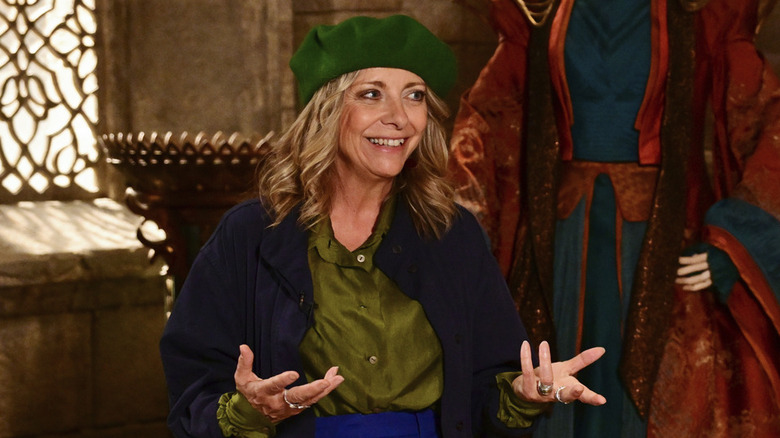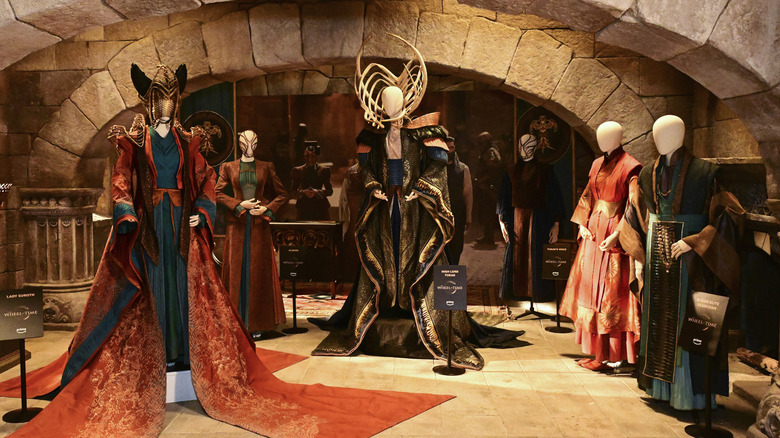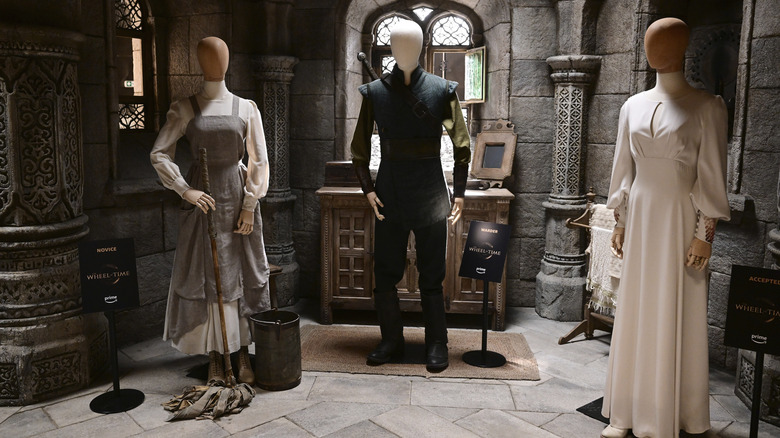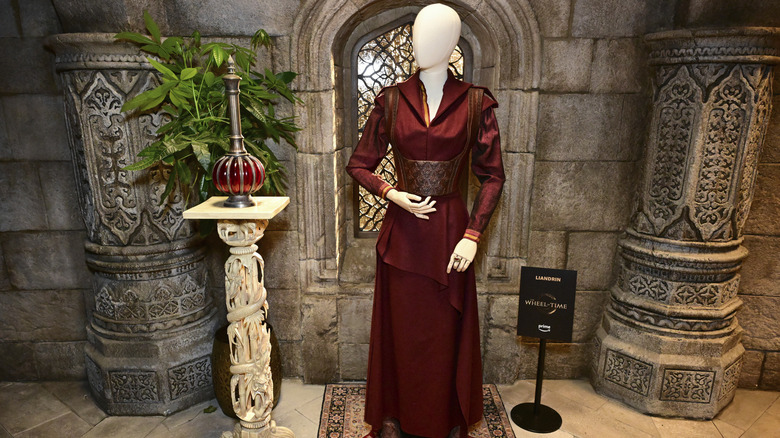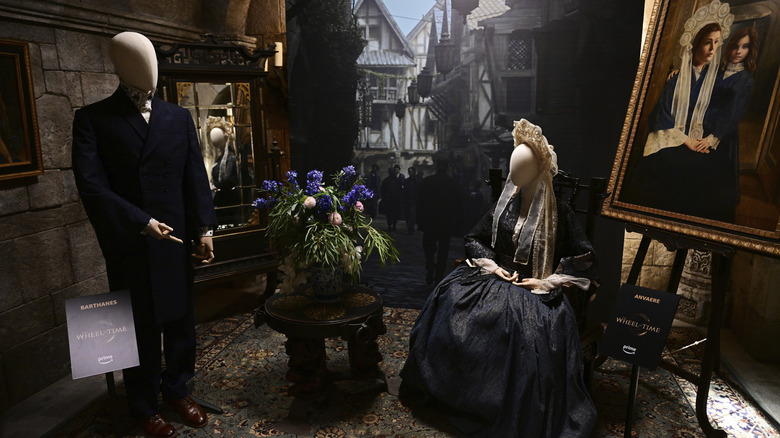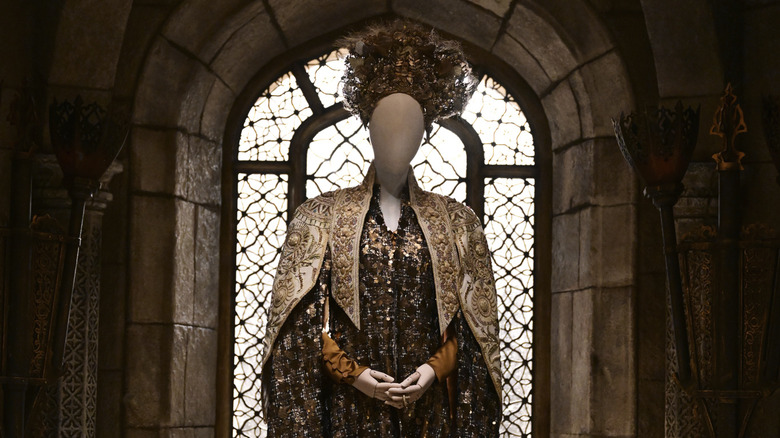Wheel Of Time S2: Sharon Gilham Breaks Down Real-Life Inspiration Behind New Costumes - Exclusive Interview
Amazon Studios' "The Wheel of Time" series has come out swinging for Season 2. After sub-par ratings for the show's initial foray into Robert Jordan's universe, the adaptation has started to pick up steam (and a ratings boost, to boot) in Season 2. Part of this growing momentum is the fractionalization of the main group of heroes. As Rand, Egwene, Perrin, and others scatter across the landscape, they are quickly encountering more and more resistance. The Dark One and his Forsaken are hunting them, and they are encountering new friends and foes alike.
This growing on-screen world is colorful and varied. It features different races, like the Ogier and Trollocs, as well as countless human cultures and groups, including the people of the Two Rivers, Shienarans from the northern borderlands, the Aes Sedai of the White Tower, and the overseas Seanchan invaders.
Looper was recently invited to get a behind-the-scenes look at how the show is created at Jordan Studios in Prague. During our time on set, we visited with the show's costume designer, Sharon Gilham, who took us on a tour that encompassed multiple sets and dozens of costumes on mannequins, and she gave us a peek behind the colorful curtain at what's to come in Season 2.
The Seanchan and cultural colors
With so many cultures and climates in places in this world — we're in front of the Seanchan now for Season 2 — has there been a section of the world that you've really enjoyed bringing to life visually through costumes?
It's all been enjoyable. It's such a rich tapestry of a world that Robert Jordan has created, and each one has such an individual look to it and a feel to it. His descriptions of it are so detailed that it's an absolute dream for a costume designer because it's a mix of cultures, and you can take things from any period of time.
The constraint is that it has to look like it was made pre-industrial revolution. You've got loads of freedom and then some constraints, which is great — because otherwise, it could be anything, anywhere, all the time. With the cultures that I've created, I've given them a color palette so that they're easily identifiable as people move in and out of the different worlds and environments.
Interesting. What is the color palette of the Seanchan? Is there a primary color? Is it the red?
The Seanchan is a mix, like a rusty metal color palette. It's quite varied, actually. Some of the other ones are more specific, maybe two or three colors. But this is any color in the world of rusted metal — it's all of those. There's also the Mesoamerican parts of the Seanchan cultural mix. It's part imperial Chinese and part Mesoamerican. The turquoise-y colors come in from the Mesoamerican side.
That's a wild inspiration. You can see those two in there.
That's the thing — to take some of these elements that are quite abstract, but so they make sense in the whole. Also, one of the things in the Mesoamerican world is feathered headdresses, which we started thinking about for the Deathwatch. Then we felt it was a bit too much cultural appropriation. The feathers now are ... Turak has feathers in his costume on his shoulders, and Suroth's headdress, this part, is made of feathers. So we are keeping those ideas in there but twisting them slightly.
One question on the Aes Sedai costumes — the women themselves walk the line between graceful and strong. How have you reflected that element in their actual costumes?
Well, behind that door are some Aes Sedai costumes. Should we go through and have a look?
That'd be great ... These [Seanchan costumes] are amazing. How did you come up with that idea?
I've got an amazing team of people. The idea with them was this insect-like look. We wanted to make a collar, and I've got an amazing couture leathermaker who's got the most incredible brain. I can say, "Let's talk about insects; let's talk about creatures," and he'll go, "How about this?"
So did you come up with a design, and he made it?
I have an illustrator who interprets some of my ideas, and then [the leathermaker builds] them.
In the White Tower
Sharon Gilham [continued]: We're walking into the White Tower now — this is the actual set from Season 2 of the White Tower that we're in. These are the corridors that Nynaeve and Egwene walk down. Then here, this is an example of some of the social hierarchy of the White Tower, which is new for Season 2.
Nynaeve and Egwene are novices, so they're dressed like that. Nynaeve is going against the system, so she's wearing her wisdom belt, and she's kept her hair in a braid. This is a Warder costume, and this is an Accepted costume with the colors of the Ajah on the cuffs.
Are the Warder costumes fairly consistent, or do they change depending on the Warder?
They're all individual. The color palette of the Warders is green and gray; I think that's in the books. We keep to that, but they all have a slightly different look — sort of similar different elements, but the same silhouette.
Who is this one? Is this going to one character?
No, this is a crowd one ... Down this corridor, we have some of the Aes Sedai costumes from Season 2, some of the cast costumes. We haven't got all the colors featured here, but this is Joiya, who's a Gray Aes Sedai, a mediator. I've added another element in this season, an element for each color of the Ajah. [For] the Grays, I've used this idea of weaving in the costumes, because they're mediators — they're connecting.
The Greens — you've seen Alanna; she's got a lot of jewelry on. The idea is that they're warriors, but they don't need armor because they have the One Power, so they wear jewelry as armor. That's the idea.
Is it all individual, different kinds of jewelry?
All individual. Every Aes Sedai has a complete, different look.
Lots of designing.
Even the crowd — it's very important that they also all have their own looks. This is Sheriam, who's a new character for Season 2. She's the mistress of novices, and she's a Blue. [For] the Blues, I've used the idea of flowing fabrics and movement because they're spies, so they're moving through the whole world, finding the right place to be. I've interpreted that as a flowing movement in fabrics.
This shawl — do they all have the shawl or is that because she's the mistress?
No, this is just part of this costume, actually. We haven't yet developed the idea of the shawls. We haven't got to that point, but it's a plan for the future because it's very important in the books.
More Aes Sedai colors
Sharon Gilham [continued]: This is Adeleas and Verin. They're sisters. She's retired, so she's like, "No more color for me. I'm doing what I want."
Or all the colors, right?
Yes. Exactly.
It looks very Aes Sedai without being Aes Sedai.
Great — exactly. The actress, when I showed her this costume, she said, "If my soul could choose a costume, this would be it."
That's wonderful.
I was [like], "I don't need to do anything else. I can stop working now. That's it."
That's great. How about Verin's costume?
Verin is the Browns. I wanted to keep them quite formal. They're the keepers of the knowledge. They're very sensible in that way, with some white collars and cuffs, and elements in their costumes that remind you of books and leaves in the books.
The pages?
Yes — this is the pages of a book and the underlayer of this that you've seen in Episode 1 — when they're in Arafel, you can really see the layers and the leaves.
The Yellows are healers. What was the element that you wove into that?
The idea was that they were quite practical, but they had a lacy or soft or decorative element to them. There was one reference picture that we found of Marie Curie, who [discovered radium], and she was wearing a very practical overlay, but she had this beautiful lacy sleeve ... That's where that idea came from.
Very cool. I like it.
Then, Liandrin is here on her own, being individual, standing out. I've made her costumes much darker red this season as she's getting darker, going to the dark side.
Are all the Reds doing that, or is it just for Liandrin?
No, it's just for her. She's ...
Inching toward a different color?
Yes. And they're corseted belts and things like that because [they're] very restrained and very controlling, and they're police, that idea with the epaulets and things to give that idea of that side of them. So to answer your question, all of the Ajahs have been rejigged and reinvented so that they've got a beautiful, couture kind of feel to them. But they are very much individuals.
Culture in Cairhien
Sharon Gilham [continued]: This is the world of Cairhien, which is another new culture for this season. You can have a little glance in here, a little taster ... This is a party scene in Cairhien coming up.
This looks very rich, very Gilded Age. Almost Renaissance.
Exactly. This is Cairhien ... Cairhien is a mix of French and Japanese. In the books, it says the ladies — the upper classes — wear dark colors; women wear big hoop skirts. I've taken that silhouette and added a French national costume, a traditional costume headdress with the lace, and kept the color palette blue and white. It works in the French world and in the Japanese world and makes sense. Moiraine is from here, so the blue of this world echoes her blue, as well. This is Anvaere, Moiraine's sister, and Barthanes is her nephew, and their look is much more structured.
Did you come up with that picture there?
This is [from the] Art Department, that picture, but they based it on my costume design.
It's reflected in the painting, for sure.
That's very exciting when that happens. That doesn't happen often.
It's great.
This is Foregate. Rand in the Foregate — [he's] still in the Cairhien color palette, but much rougher, and Selene. This is Moiraine — this picture's been in social media and so on — in her upper-class Cairhien outfit that is coming up.
This is a blue-gray?
Yes. This is a bluish-gray that keeps in that world but looks much more ...
Down to earth?
Exactly. Poor, poverty-stricken. Then, up here, this is Siuan Sanche's traveling costume that you've seen in some of the trailers.
How many costumes have you made for her character? It's got to be a lot, right?
About three. She isn't one of the ones who has the most costumes. There is one character who has many costumes, and [showrunner] Rafe [Judkins] was like, "We need to stop making costumes for this character."
Final questions and thoughts on costumes
Sharon Gilham [continued]: I know there's so much to see — this is Suroth in her chambers. This is like the Seanchan relaxed, so [it's] the same color palette as is in there: the rusted metal, but softer, keeping that same thing going.
Do you have a favorite?
I have many favorites, and I can't talk about most of them at the moment because you've only seen those first two episodes.
Do you have a favorite culture that you've designed?
The Seanchan was an amazing thing to design because it was the first thing I had to do, and it was such a huge, important part of Season 2. At the moment, that is my favorite because it was from scratch to something incredibly elaborate and dangerous.
Wow, that's great ... This has been great to see all this in person. We walked through the Tower, Cairhien, then back into Seanchan.
Yes. It was White Tower, Siuan Sanche's in the middle, back round to Cairhien, and then back to Seanchan ... Enjoy. This is just the tip of the iceberg.
The first three episodes of Season 2 of "The Wheel of Time" are available to stream on Prime Video. The remaining episodes will premiere on Fridays through October 6, 2023.
This interview has been edited for clarity.
